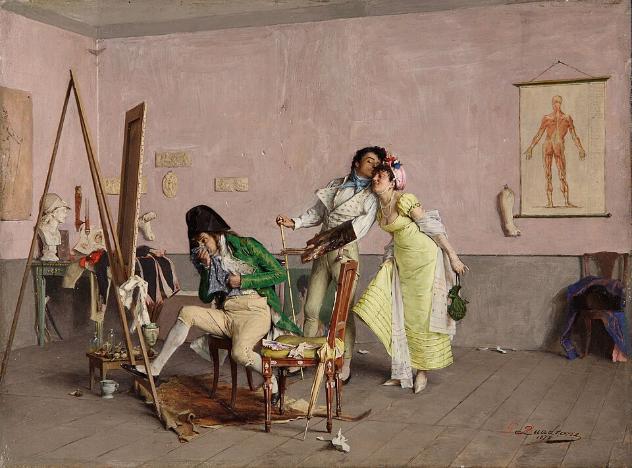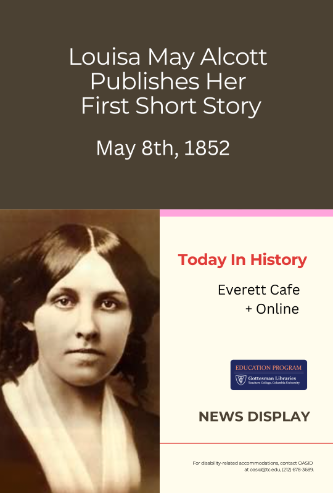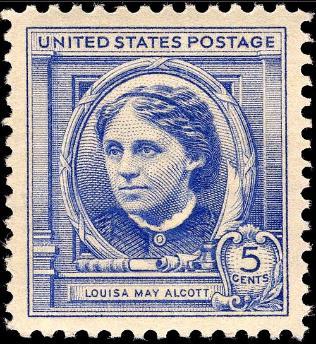Today In History: Louisa May Alcott Publishes Her First Short Story
"Farewell, my son and go trustingly forth, carve thine own fortunes with by untiring efforts, and it will be doubly enriched by those memories of patient toil that gained so much happiness for thee. The world is bright and beautiful to a young heart, but its light and loveliness pass away. Set not, therefore, too great a value upon riches. Walk calmly in the quiet path that leads to thy duty, envying none, loving all, and a purer and more lasting joy will be thine, than the praise and homage a flattering world can give thee. Fear nothing but sin and temptation, follow only the dictates of thy innocent heart. Be faithful to thy friends, forgiving to thine enemies, true to thyself, and earnest in thy love to God, with a mother's blessing on thy head, fare thee well."
-- Louisa May Alcott, "The Rival Painters"
So opens "The Rival Painters: A Tale of Rome": a mother's words to her son as he leaves his quiet home for the capital city where all his hopes and desires are centered.
On May 8th, 1852, Louisa May Alcott's "The Rival Painters: A Tale of Rome" was published by The Boston Olive Branch, a weekly paper that circulated from 1836-1857, with elegant, refined writing and leanings toward Christianity. The first-known printed publication of Louisa May Alcott, this story appeared anonymously by the beloved 19th century American author, poet, and short story writer, well-known for her semi-biographical novel, Little Women, or Meg, Jo, Beth and Amy (1868), and its successive publications: Good Wives: A Story for Girls (1869), Little Men: Life at Plumfield with Jo's Boys (1871), and Jo's Boys and How They Turned Out: A Sequel to Little Men (1886). At the age of 20 years, Alcott was paid a mere $5 for her first short story, but it would mark the beginning of prolific career in which she also wrote mysteries and thrillers, at times anonymously, or under the pen name, A.M. Barnard and possibly E.H. Gould.
"The Rival Painters: A Tale of Rome" explores the romantic and artistic rivalry between Guido, a humble young Florentine painter, and Ferdinand, a fellow student with wealth and rank. They vie for the affection of Madeline, the beautiful and good daughter of an experienced and sympathetic art teacher. Deferring to her father for advice, he proposes a portraiture contest, where the most beautiful painting will to determine her hand in marriage. While the count paints fair young Madeline, Guido paints his self-sacrificing and loving mother who gave everything for his education and pursuit of art.
Certain themes emerge: social norms and expectations of women; the value of hard work over inherited wealth; true meaning of happiness; and Italy as inspiration for art. Interestingly, Alcott's story contains flowery language and noble sentiments, while Italian portrait painting of the mid 1850s would begin transitioning from Romanticism to Realism. In other works by Louisa May Alcott, Americans sought Italy to develop socially and artistically; Amy March in Little Women, for example, ventures to Europe with her mother to mingle with upper class society, with a view to marriage, and she takes art lessons in Italy to further her career as a painter -- not unlike Louisa May's sister, Abigail May who travelled to Europe to study with notable artists in England and France.
The following articles are drawn from Proquest Historical Newspapers, which informs and inspires classroom teaching and learning.
- Furman, D. (1898, Apr 09). Books Worth Reading Again.: " When a New Book Comes Out I Read an Old One." -- Emerson. XI. Louisa ay Alcott's Life and Letters.*. New York Times (1857-1922)
- Brewster, C, F. (1900, Jun 09). The Times' Home Study Circle.: Directed by Prof. Seymour Eaton. Biographical Studies for Girls. XVII.--Louisa May Alcott. Los Angeles Times (1886-1922)
- Bell, M. (1923, ). Children of History and Legend: LV--Louisa May Alcott. Boston Daily Globe (1923-1927)
- Louisa May Alcott's Climb to Literary Fame: Famous Authoress, Born 100 Years Ago Tuesday, Had Hard Struggle to Aid Her 'Pathetic' Family. (1932, Nov 27). The Hartford Courant (1923-)
- Taylor, M.J. (1932, Nov 29). Alcott Books Still Are Loved as Centenary of Writer Passes: 'Little Women' Found Ad Fresh and Modern as Though Just Off the Press, While Reminiscences of Author Emphasize Clearness of Her Vision Something Mythical. The Christian Science Monitor (1908-)
- McAleer, J. (1968, Oct 27). Remember Louisa? Boston Globe (1960-)
- Shaw, C. L. (1987, Oct 22). Bronson Alcott's Other Daughter: Overshadowed by Her Famous Sister, Abigail May Was Talented, Too. The Christian Science Monitor (1908-)
- Getting to Know You, Louisa. (1993, Aug 29). Boston Globe (1960-)
- McClurg, J. (1993, Oct 24). Concord's One for the Books: Homes of Four Literary Giants Offer a Glimpse of Writing Genius. Newsday (1940-)
- Graham, R. (1994, Dec 15). The Alcotts Slept Here. Boston Globe (1960-)

Tips:
- Alcott, Louisa May et al. The Selected Letters of Louisa May Alcott. First edition. Boston: Little, Brown, 1987. Stacks ; PS1018 .A44 1987.
- Clark, Beverly Lyon. Louisa May Alcott : The Contemporary Reviews. 1st ed. Cambridge, UK ; Cambridge University Press, 2004. e-book.
- Eiselein, Gregory, and Anne K Phillips. The Louisa May Alcott Encyclopedia. 1st ed. Westport, Conn: Greenwood Press, 2001. e-book.
- MacDonald, Ruth K. Louisa May Alcott. Boston, Mass: Twayne Publishers, 1983. e-book.
- Moses, Belle. Louisa May Alcott, Dreamer and Worker : A Story of Achievement / by Belle Moses. New York (State): D. Appleton and Co., 1916, [c1909], 1909. e-book.
- Reisen, Harriet. Louisa May Alcott : The Woman Behind Little Women. 1st ed. New York: Henry Holt, 2009. Curriculum ; PS1018 .R45 2009.
- Shealy, Daniel. Alcott in Her Own Time : A Biographical Chronicle of Her Life, Drawn from Recollections, Interviews, and Memoirs by Family, Friends, and Associates. 1st ed. Iowa City: University of Iowa Press, 2005. e-book.

Images:
- Ogni Occasione è Buona (Every Occasion Is Good), by Giovanni Battista Quadrone, 1878, Courtesy of Wikimedia Commons.
- Louisa May Alcott, 5c, 1940 Issue, Courtesy of Wikimedia Commons.
- Louisa May Alcott, at Age 20, Courtesy of Wikimedia Commons.
Need to keep current, look to the past, teach a topic? The Everett Cafe features daily postings of news from around the world, and also promotes awareness of historical events from an educational context. Be sure to check additional Cafe News postings on the library blog.


